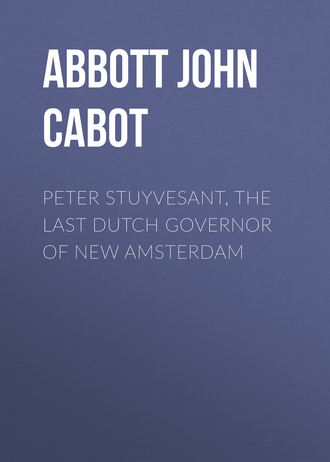 полная версия
полная версияPeter Stuyvesant, the Last Dutch Governor of New Amsterdam

John S. C. Abbott
Peter Stuyvesant, the Last Dutch Governor of New Amsterdam
PREFACE
It is impossible to understand the very remarkable character and career of Peter Stuyvesant, the last, and by far the most illustrious, of the Dutch governors of New Amsterdam, without an acquaintance with the early history of the Dutch colonies upon the Hudson and the Delaware. The Antiquarian may desire to look more fully into the details of the early history of New York. But this brief, yet comprehensive narrative, will probably give most of the information upon that subject, which the busy, general reader can desire.
In this series of "The Pioneers and Patriots of America," the reader will find, in the "Life of De Soto," a minute description of the extreme south and its inhabitants, when the Mississippi rolled its flood through forests which the foot of the white man had never penetrated. "Daniel Boone" conducts us to the beautiful streams and hunting grounds of Kentucky, when the Indian was the sole possessor of those sublime solitudes. In the "Life of Miles Standish, the Puritan Captain," we are made familiar with that most wonderful of all modern stories, the settlement of New England. "Peter Stuyvesant" leads us to the Hudson, from the time when its majestic waters were disturbed only by the arrowy flight of the birch canoe, till European colonization had laid there the foundations of one of the most flourishing cities on this globe.
In these Histories the writer has spared no labor in gathering all the information in his power, respecting those Olden Times, now passing so rapidly into oblivion.
JOHN S. C. ABBOTT.CHAPTER I.
DISCOVERY OF THE HUDSON RIVER
The Discovery of America.—Colonies.—The Bay of New York.—Description of the Bay.—Voyage of Sir Henry Hudson.—Discovery of the Delaware.—The Natives.—The Boat Attacked.—Ascending the Hudson.—Escape of the Prisoners.—The Chiefs Intoxicated.—The Return.—The Village at Castleton.—The Theft and its Punishment.—The Return to England.
On the 12th of October, 1492, Christopher Columbus landed upon the shores of San Salvador, one of the West India islands, and thus revealed to astonished Europe a new world. Four years after this, in the year 1496, Sebastian Cabot discovered the continent of North America. Thirty-three years passed away of many wild adventures of European voyagers, when, in the year 1539, Ferdinand de Soto landed at Tampa Bay, in Florida, and penetrating the interior of the vast continent, discovered the Mississippi River. Twenty-six years more elapsed ere, in 1565, the first European colony was established at St. Augustine, in Florida.
In the year 1585, twenty years after the settlement of St. Augustine, Sir Walter Raleigh commenced his world-renowned colony upon the Roanoke. Twenty-two years passed when, in 1607, the London Company established the Virginia Colony upon the banks of the James river.
In the year 1524, a Florentine navigator by the name of Jean de Verrazano, under commission of the French monarch, Francis I., coasting northward along the shores of the continent, entered the bay of New York. In a letter to king Francis I., dated July 8th, 1524, he thus describes the Narrows and the Bay:
"After proceeding one hundred leagues, we found a very pleasant situation among some steep hills, through which a very large river, deep at its mouth, forced its way to the sea. From the sea to the estuary of the river, any ship heavily laden might pass, with the help of the tide, which rises eight feet. But as we were riding at anchor, in a good berth, we would not venture up in our vessel without a knowledge of the mouth. Therefore we took the boat, and entering the river, we found the country, on its banks, well peopled, the inhabitants not much differing from the others, being dressed out with the feathers of birds of various colors.
"They came towards us with evident delight, raising loud shouts of admiration, and showing us where we could most securely land with our boat. We passed up this river about half a league, when we found it formed a most beautiful lake three leagues in circuit, upon which they were rowing thirty or more of their small boats, from one shore to the other, filled with multitudes who came to see us. All of a sudden, as is wont to happen to navigators, a violent contrary wind blew in from the sea, and forced us to return to our ship, greatly regretting to leave this region which seemed so commodious and delightful, and which we supposed must also contain great riches, as the hills showed many indications of minerals."
In the year 1609, a band of Dutch merchants, called the East India Company, fitted out an expedition to discover a northeast passage to the Indies. They built a vessel of about eighty tons burden, called the Half Moon, and manning her with twenty sailors, entrusted the command to an Englishman, Henry Hudson. He sailed from the Texel in his solitary vessel, upon this hazardous expedition, on the 6th of April, 1609. Doubling North Cape amid storms and fog and ice, after the rough voyage of a month, he became discouraged, and determined to change his plan and seek a northwest passage.
Crossing the Atlantic, which, in those high latitudes, seems ever to be swept by storms, he laid in a store of codfish on the banks of Newfoundland, and, on the 17th of July, ran his storm-shattered bark into what is now known as Penobscot Bay, on the coast of Maine. Here he found the natives friendly. He had lost his foremast in a storm, and remained at this place a week, preparing a new one. He had heard in Europe that there was probably a passage through the unexplored continent, to the Pacific ocean, south of Virginia. Continuing his voyage southward, he passed Cape Cod, which he supposed to be an island, and arrived on the 18th of August at the entrance of Chesapeake Bay. He then ran along the coast in a northerly direction and entered a great bay with rivers, which he named South River, but which has since received the name of the Delaware.
Still following the coast, he reached the Highlands of Neversink, on the 2d of September, and at three o'clock in the afternoon of the same day, came to what then seemed to him to be the mouths of three large rivers. These were undoubtedly the Raritan, the Narrows, and Rockaway Inlet. After careful soundings he, the next morning, passed Sandy Hook and anchored in the bay at but two cables' length from the shore. The waters around him were swarming with fish. The scenery appeared to him enchanting. Small Indian villages were clustered along the shores, and many birch canoes were seen gliding rapidly to and fro, indicating that the region was quite densely populated, and that the natives were greatly agitated if not alarmed by the strange arrival.
Soon several canoes approached the vessel, and the natives came on board, bringing with them green tobacco and corn, which they wished to exchange for knives and beads. Many vessels, engaged in fishing, had touched at several points on the Atlantic coast, and trafficked with the Indians. The inhabitants of this unexplored bay had heard of these adventurers, of the wonders which they brought from distant lands, and they were in a state of great excitement, in being visited in their turn.
The bay was fringed with the almost impenetrable forest. Here and there were picturesque openings, where Indian villages, in peaceful beauty, were clustered in the midst of the surrounding foliage. The natives were dressed in garments of deer skin, very softly tanned, hanging gracefully about their persons, and often beautifully ornamented. Many of them wore mantles of gorgeously-colored feathers, quite artistically woven together; and they had also garments of rich furs.
The following morning a party from the vessel landed, in a boat, on the Jersey shore. They were received with great hospitality by the natives, who led them into their wigwams, and regaled them with dried currants, which were quite palatable. As they had no interpreters, they could only communicate with each other by signs. They found the land generally covered with forest trees, with occasional meadows of green grass, profusely interspersed with flowers, which filled the air with fragrance.
Another party of five men, was sent to examine the northern shore of the bay. They probably inflicted some gross outrage upon the natives, as the crew of the Half Moon had conducted infamously, at other points of the coast, where they had landed, robbing and shooting the Indians. The sun had gone down, and a rainy evening had set in, when two canoes impelled rapidly by paddles, overtook the returning boat. One contained fourteen Indians; the other twelve. Approaching within arrow shot, they discharged a volley into the boat. One of these keen-pointed weapons, struck John Coleman in the throat, and instantly killed him. Two other Englishmen were wounded.
The Indians seemed satisfied with their revenge. Though they numbered twenty-six warriors, and there were but two white men left unwounded, the savages permitted them to continue their passage to the vessel, without further molestation. The journalist, who records this assault, is silent respecting the provocation which led to it.
Hudson was alarmed by this hostility, and expected an immediate attack upon the ship. He promptly erected bulwarks along the sides of his vessel as a protection from the arrows of the fleet of war canoes, with which, he supposed, he would be surrounded the next morning.
But the night passed quietly away; the morning dawned, and a few canoes approached from another part of the bay, with no signs of hostility. These peaceful Indians had manifestly heard nothing of the disturbance of the night before. They came unarmed, with all friendly attestations, unsuspicious of danger, and brought corn and tobacco, which they offered in exchange for such trinkets as they could obtain. The next morning, two large canoes approached from the shores of the bay which was many leagues in extent, one of which canoes seemed to be filled with warriors, thoroughly armed. The other was a trading boat.
It is probable that those in the war canoe, came as a protection for their companions. It is hardly conceivable that the Indians, naturally timid and wary, could have thought, with a single war canoe containing scarcely a dozen men, armed with arrows, to attack the formidable vessel of Sir Henry Hudson, armed, as they well knew it to be, with the terrible energies of thunder and lightning.
The Indians were so unsuspicious of danger, that two of them unhesitatingly came on board. Sir Henry, we must think treacherously, seized them as prisoners, and ordered the canoes containing their companions, to keep at a distance. Soon another canoe came, from another direction, with only two men in it. Sir Henry received them both on board, and seized them also as prisoners. He intended to hold them as hostages, that he might thus protect himself from any hostility on the part of the natives.
One of these men upon finding himself a captive, leaped overboard and swam ashore. Sir Henry had now three prisoners and he guarded them very closely. Yet the natives, either from policy or from fear, made no hostile demonstrations against him.
The half Moon remained in the outer bay nine days. Several exploring tours had been sent out, visiting what is now known as the Jersey shore. None of these, with the exception of the one to which we have alluded, encountered any hostility whatever from the natives.
On the 11th of September, Hudson sailed through the Narrows, and anchored in the still and silent waters of New York harbor. These waters had never then been whitened by a sail, or ploughed by any craft larger than the Indian's birch canoe. The next morning, the 12th of September, Sir Henry again spread his sails, and commenced his memorable voyage up the solitary river, which has subsequently borne his name. Only here and there could a few wigwams be seen, scattered through the forest, which fringed its banks. But human life was there, then as now, with the joys of the bridal and the grief of the burial. When we contemplate the million of people, now crowded around the mouth of the Hudson, convulsively struggling in all the stern conflicts of this tumultuous life, it may be doubted whether there were not as much real happiness in the wigwam of the Indian as is now to be found in the gorgeous palace of the modern millionaire. And when we contemplate the vices and the crimes which civilization has developed, it may also be doubted whether, there were not as much virtue, comparatively with the numbers to be found, within the bark hut of the red man, as is now to be found in the abodes of the more boastful white man.
Sir Henry Hudson hoped to find this majestic river, inviting him into unknown regions of the north, to be an arm of the sea through which he could cross the continent to the shores of the Pacific. It was not then known whether this continent were a few miles or thousands of miles in breadth. For the first two days the wind was contrary, and the Half Moon ascended the river but about two miles. The still friendly natives paddled out from the shores, in their bark canoes in great numbers, coming on board entirely unarmed and offering for sale, excellent oysters and vegetables in great abundance.
On the third day a strong breeze sprang up from the southeast. All sail was set upon the Half Moon. It was a bright and beautiful autumnal day. Through enchanting scenery the little vessel ploughed the waves of the unknown river, till, having accomplished forty miles, just at sunset they dropped their anchor in the still waters which are surrounded by the grand and gloomy cliffs of the Highlands.
The next morning, the river and its shores, were enveloped in a dense fog, so that one could see but a few yards before him. Taking advantage of this, the Indian captives, whom Sir Henry Hudson had so treacherously ensnared, leaped out of one of the port-holes, and swam ashore. As soon as they reached the land, they raised loud shouts of hatred and defiance.
The sun soon dispelled the fog, and the voyage was continued, and by night the Half Moon reached a point supposed to be near the present site of Catskill Landing. The natives were numerous, and very friendly. They came freely on board, apparently unsuspicious of danger. It was noticeable that there were many very aged men among them. The river seemed full of fishes, and with their hooks they took large numbers. The next day the Indians came on board in crowds, bringing pumpkins and tobacco. The vessel's boats were sent on shore to procure fresh water.
Early the ensuing morning, they pushed up the river five miles, to a point probably near the present city of Hudson.
Sir Henry Hudson does not appear to advantage in the account transmitted to us of this exploration. Mr. Sparks, in his American Biography, gives the following extraordinary account of one of his procedures.
"It is evident that great distrust was entertained by Hudson and his men towards the natives. He now determined to ascertain, by intoxicating some of the chiefs, and thus throwing them off their guard, whether they were plotting any treachery. He accordingly invited several of them into the cabin, and gave them plenty of brandy to drink. One of these men had his wife with him, who, the Journal informs us, 'sate so modestly as any of our countrywomen would do in a strange place.' But the men had less delicacy and were soon quite merry with the brandy.
"One of them, who had been on board from the first arrival of the ship, was completely intoxicated, and fell sound asleep, to the great astonishment of his companions, who probably feared that he had been poisoned; for they all took to their canoes and made for the shore, leaving their unlucky comrade on board. Their anxiety for his welfare soon induced them to return; and they brought a quantity of beads, which they gave him, perhaps to enable him to purchase his freedom from the spell which had been laid upon him.
"The poor savage slept quietly all night, and when his friends came to visit him the next morning they found him quite well. This restored their confidence, so that they came to the ship again in crowds, in the afternoon, bringing various presents for Hudson. Their visit which was one of unusual ceremony is thus described in the Journal:
"'So at three of the clock in the afternoon, they came aboard and brought tobacco and more beads, and gave them to our master, and made an oration and showed him all the country round about. Then they sent one of their company on land, who presently returned; and brought a great platter full of venison, dressed by themselves, and they caused him to eat with them. Then they made him reverence and departed, all save the old man that lay aboard.'"
It was now manifest that no northwest passage to the Indies could be found in this direction, and it was not deemed expedient to attempt to ascend the river any farther in the ship. The mate, however was sent with a boat's crew, to explore the river some distance higher up. It is supposed that the boat ascended several miles above the present site of the city of Albany, Hudson probably going a little beyond where the town of Waterford now is. Upon the return of the boat, the mate having reported that it was useless to attempt any farther ascent of the river with the ship, Sir Henry commenced his return.
Carefully descending the winding channel of the stream, he was so unfortunate as to run the ship on a mud bank, in the middle of the river nearly opposite the present city of Hudson. Without much difficulty the vessel was again floated, having received no injury. But contrary winds detained him upon the spot two days. In the meantime several boat parties visited the banks on both sides of the stream. They were also visited by many of the natives who were unremitting in their kindness.
A fair wind soon springing up they ran down the river eighteen miles, passing quite a large Indian village where Catskill now stands, and cast anchor in deep water, near Red Hook. Baffled by opposing winds and calms, they slowly worked their way down the stream, the next two days, to near the present point of Castleton. Here a venerable old man, the chief of a small tribe, or rather patriarchal family of forty men and seventeen women, came on board in his birch canoe. He gave Sir Henry a very cordial invitation to visit his little settlement of wigwams, picturesquely nestled upon the banks of the river. Distance lends enchantment to the view. The little hamlet in a sheltered cove where fertile meadows were spread out, was surrounded by fields waving with the harvest. From the deck of the ship the scene presented was one of peace, prosperity and happiness. The smoke ascended gracefully from the wigwam fires, children were sporting upon the beach, and birch canoes, almost as light as bubbles, were being rapidly paddled over the glassy waves.
The good old chief took the English captain ashore and led him into his palace. It was a very humble edifice, constructed of bark so carefully overlapped as effectually to exclude both wind and rain. It was from thirty to forty feet long and eighteen feet wide. There was a door at each end, and ample light was admitted by an opening extending along the whole length, through which the smoke of the fires could escape. The interior was finished with great care, and very smoothly. Under certain states of the atmosphere and of the wind the smoke freely ascended, causing no embarrassment to those within. The ground floor was neatly covered with mats, except in the centre where the fire was built. The whole interior as Sir Hudson entered it, on a serene autumnal day, presented a very cheerful aspect. One might easily be pardoned for imagining, in that hour, that the life of the American savage, free from care, was apparently far more desirable than that of the toil-worn European.
Sir Henry, with the few who accompanied him, was received with great hospitality. Some Indians were immediately sent into the forest for a dinner. They soon returned with some pigeons which they had shot with their arrows. A nice fat puppy was also killed, skinned with a clam-shell, and roasted in the highest style of barbaric culinary art. Thick mats were provided as seats for the guests at this royal festival. Hudson was urged to remain all night. He was evidently a man of very cautious, if not suspicious temperament. He could not, or did not conceal, from the Indians his fears that they were meditating treachery. These artless men, to convince him that he had nothing to apprehend, actually broke their bows and arrows, and threw them into the fire. But nothing could induce Hudson to remain on shore through the night. He describes the land here as very fertile, bearing abundantly, corn, pumpkins, grapes, plums, and various other kinds of small fruits.
Availing himself of a fair wind, he again spread his sails, and on the 1st of October, cast anchor at the mouth of Haverstraw Bay, in the vicinity of Stony Point. He had scarcely furled his sails, when a large number of natives came paddling out from the shore in their little birch canoes. They were entirely unarmed, bringing apparently in a most friendly manner, furs, fish and vegetables for sale. Soon quite a little fleet of these buoyant canoes were gliding over the water. One Indian, paddling beneath the cabin windows, and seeing hanging out certain articles pilfered a pillow and a jacket. As he was making off with his treasures the mate caught sight of him, and seizing his gun mercilessly shot him dead. A severe punishment for so trivial a crime in an untutored savage.
All the Indians on board the Half Moon as they heard the report of the gun, and saw their unfortunate companion fall dead in his blood, were stricken with terror. Some rushed into their canoes. Others plunged into the river to swim ashore. The vessel's boat immediately put off to pick up the canoe with the stolen goods. As it was returning, a solitary Indian, in the water, probably exhausted and drowning, grasped the gunwale. The cook seized a hatchet and with one blow, deliberately cut off the man's hand at the wrist. The poor creature, uttering a shriek, sank beneath the crimsoned waves and was seen no more.
The next day, the Half Moon descended the river about twenty miles through Tappan Sea, and anchored, it is supposed, near the head of Manhattan island. Sir Henry Hudson was apparently oppressed in some degree with the unjustifiable harshness with which he had treated the simple-hearted, yet friendly natives. He was continually and increasingly apprehensive of treachery. A single canoe containing several men approached the ship Hudson's eagle eye perceived that one of these men was one of the captives whom he had seized, but who had escaped from his imprisonment by plunging into the river and swimming ashore. The sight of this man alarmed the captain, and he refused to allow any of them to come on board.
It seems to us rather absurd to suppose that half-a-dozen savages could think of attacking, from a birch canoe, with arrows, a European ship with its well-armed crew. It should be borne in mind that we have the narrative from the white man only. The Indians have had no opportunity to tell their story.
Mr. Brodhead, in his valuable history of New York, gives the following account of the untoward scenes which immediately ensued, compiling from the most ancient records:
"But Hudson, perceiving their intent, would suffer none of them to enter the vessel. Two canoes, full of warriors, then came under the stern, and shot a flight of arrows into the yacht. A few muskets were discharged in retaliation, and two or three of the assailants were killed. Some hundred Indians then assembled at the Point to attack the Half Moon, as she drifted slowly by; but a cannon-shot killed two of them, whereupon the rest fled into the woods. Again the assailants manned another canoe and again the attack was repulsed by a cannon shot which destroyed their frail bark; and so the savages went their way mourning the loss of nine of their warriors. The yacht then got down two leagues beyond that place, and anchored over night on the other side of the river in the bay near Hoboken. Hard by his anchorage and upon that side of the river that is called Mannahatta, Hudson noticed that there was a cliff that looked of the color of white-green. Here he lay wind-bound the next day, and saw no people to trouble him. The following morning, just one month after his arrival at Sandy Hook, Hudson weighed anchor for the last time and coming out of the mouth of the great river, in the which he had run so far, he set all sail and steered off again into the main sea."











